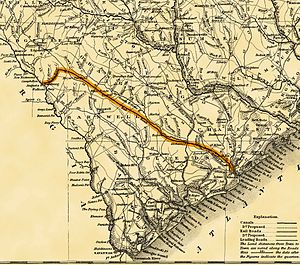South Carolina Canal and Rail Road Company
 |
|
| Locale | South Carolina |
|---|---|
| Dates of operation | 1827–1843 |
| Successor | South Carolina Railroad |
| Track gauge | 5 ft (1,524 mm) |
| Headquarters | Charleston, South Carolina |
The South Carolina Canal and Rail Road Company was chartered under act of the South Carolina General Assembly of December 19, 1827. The company operated its first 6-mile (9.7 km) line west from Charleston, South Carolina in 1830. The railroad ran scheduled steam service over its 136-mile (219 km) line from Charleston, South Carolina, to Hamburg, South Carolina, beginning in 1833. Some sources referred to the railroad informally as the Charleston and Hamburg Railroad, a reference to its end points, but that was never its legal name. In 1839, The Louisville, Cincinnati and Charleston Railroad Company, which had built no track of its own, gained stock control of The South Carolina Canal and Rail Road Company, which continued to operate under that name. In 1844, The South Carolina Canal and Rail Road Company merged with The Louisville, Cincinnati and Charleston Railroad Company. The merged company changed its name to South Carolina Railroad Company under an act of the South Carolina legislature dated December 19, 1843.
The SCC&RR holds several historical distinctions such as being one of the first railroads in North America to be chartered and constructed. The railroad also featured the first steam powered, scheduled passenger train to run in America, pulled by their first locomotive the Best Friend of Charleston.
With the advent of cotton cultivation in the early 19th century, the relatively remote South Carolina upcountry enjoyed a vast expansion in the value of its agricultural produce. Overland transport by wagon was slow and expensive, so this produce tended to go to Augusta, Georgia, then down the Savannah River to the seaport at Savannah, Georgia. The SCC&RR Company was chartered on December 19, 1827 (amended January 30, 1828) to divert this commerce to Charleston by means of connections to Columbia, Camden and Hamburg. Despite its novelty the project was pursued by its Charleston leaders with aggressive method, public demonstrations encouraging support for the daring concept of a steam-driven railroad. Under William Aiken as the first president, six miles (10 km) of line were completed at Charleston in 1830. The first run over the entire 136-mile (219 km) line was celebrated in October 1833.
...
Wikipedia
